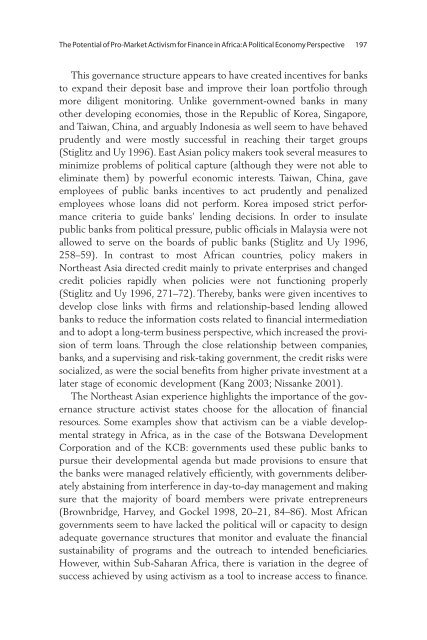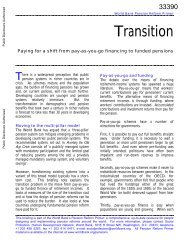Financial Sector Development in Africa: Opportunities ... - World Bank
Financial Sector Development in Africa: Opportunities ... - World Bank
Financial Sector Development in Africa: Opportunities ... - World Bank
Create successful ePaper yourself
Turn your PDF publications into a flip-book with our unique Google optimized e-Paper software.
The Potential of Pro-Market Activism for F<strong>in</strong>ance <strong>in</strong> <strong>Africa</strong>: A Political Economy Perspective 197<br />
This governance structure appears to have created <strong>in</strong>centives for banks<br />
to expand their deposit base and improve their loan portfolio through<br />
more diligent monitor<strong>in</strong>g. Unlike government-owned banks <strong>in</strong> many<br />
other develop<strong>in</strong>g economies, those <strong>in</strong> the Republic of Korea, S<strong>in</strong>gapore,<br />
and Taiwan, Ch<strong>in</strong>a, and arguably Indonesia as well seem to have behaved<br />
prudently and were mostly successful <strong>in</strong> reach<strong>in</strong>g their target groups<br />
(Stiglitz and Uy 1996). East Asian policy makers took several measures to<br />
m<strong>in</strong>imize problems of political capture (although they were not able to<br />
elim<strong>in</strong>ate them) by powerful economic <strong>in</strong>terests. Taiwan, Ch<strong>in</strong>a, gave<br />
employees of public banks <strong>in</strong>centives to act prudently and penalized<br />
employees whose loans did not perform. Korea imposed strict performance<br />
criteria to guide banks’ lend<strong>in</strong>g decisions. In order to <strong>in</strong>sulate<br />
public banks from political pressure, public officials <strong>in</strong> Malaysia were not<br />
allowed to serve on the boards of public banks (Stiglitz and Uy 1996,<br />
258–59). In contrast to most <strong>Africa</strong>n countries, policy makers <strong>in</strong><br />
Northeast Asia directed credit ma<strong>in</strong>ly to private enterprises and changed<br />
credit policies rapidly when policies were not function<strong>in</strong>g properly<br />
(Stiglitz and Uy 1996, 271–72). Thereby, banks were given <strong>in</strong>centives to<br />
develop close l<strong>in</strong>ks with firms and relationship-based lend<strong>in</strong>g allowed<br />
banks to reduce the <strong>in</strong>formation costs related to f<strong>in</strong>ancial <strong>in</strong>termediation<br />
and to adopt a long-term bus<strong>in</strong>ess perspective, which <strong>in</strong>creased the provision<br />
of term loans. Through the close relationship between companies,<br />
banks, and a supervis<strong>in</strong>g and risk-tak<strong>in</strong>g government, the credit risks were<br />
socialized, as were the social benefits from higher private <strong>in</strong>vestment at a<br />
later stage of economic development (Kang 2003; Nissanke 2001).<br />
The Northeast Asian experience highlights the importance of the governance<br />
structure activist states choose for the allocation of f<strong>in</strong>ancial<br />
resources. Some examples show that activism can be a viable developmental<br />
strategy <strong>in</strong> <strong>Africa</strong>, as <strong>in</strong> the case of the Botswana <strong>Development</strong><br />
Corporation and of the KCB: governments used these public banks to<br />
pursue their developmental agenda but made provisions to ensure that<br />
the banks were managed relatively efficiently, with governments deliberately<br />
absta<strong>in</strong><strong>in</strong>g from <strong>in</strong>terference <strong>in</strong> day-to-day management and mak<strong>in</strong>g<br />
sure that the majority of board members were private entrepreneurs<br />
(Brownbridge, Harvey, and Gockel 1998, 20–21, 84–86). Most <strong>Africa</strong>n<br />
governments seem to have lacked the political will or capacity to design<br />
adequate governance structures that monitor and evaluate the f<strong>in</strong>ancial<br />
susta<strong>in</strong>ability of programs and the outreach to <strong>in</strong>tended beneficiaries.<br />
However, with<strong>in</strong> Sub-Saharan <strong>Africa</strong>, there is variation <strong>in</strong> the degree of<br />
success achieved by us<strong>in</strong>g activism as a tool to <strong>in</strong>crease access to f<strong>in</strong>ance.







